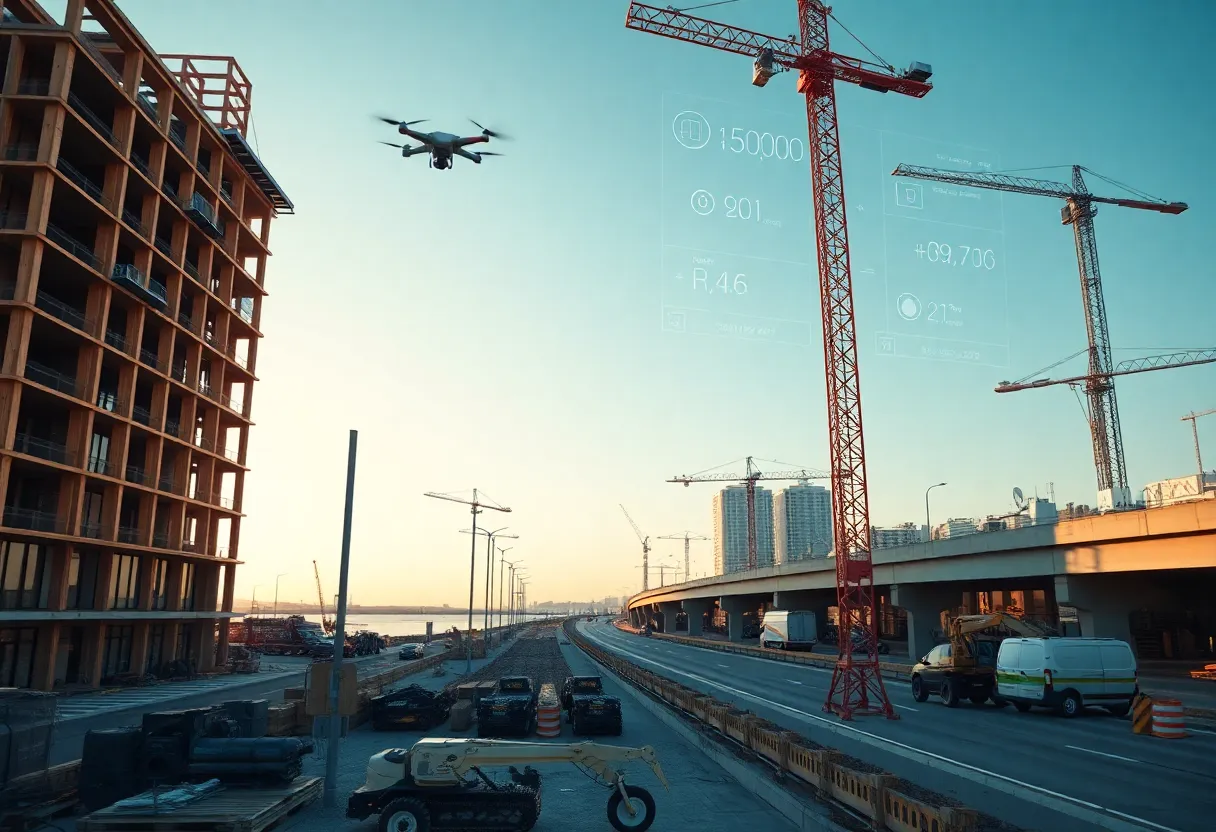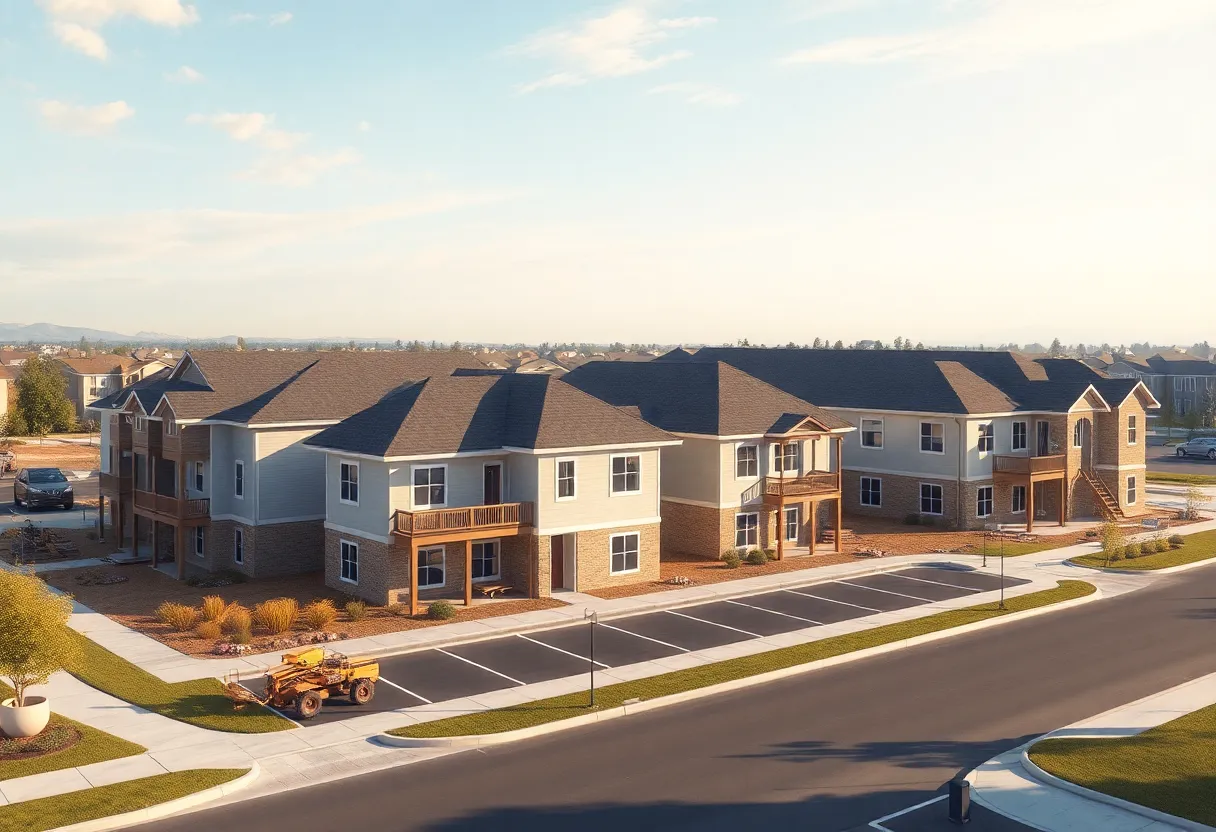Waterfront commercial project, August 21, 2025
News Summary
The construction and engineering sector is increasingly pairing enterprise resource planning (ERP) platforms with industrial AI to improve cost control, field productivity and safety. Firms are adopting centralized data backbones to enable reliable AI predictions while startups and research groups invest in mass‑timber offices, field automation agents and AI‑augmented security cameras. Use cases include automated takeoffs, drone progress measurement, predictive maintenance, and remote guarding on long linear projects. Despite momentum, many contractors remain early in digital transformation and must standardize data, integrate systems and pilot tools carefully to realize consistent benefits.
Industry push for ERP and industrial AI reshapes construction, with new AI-based tools and strategic moves leading the way
Despite ongoing economic uncertainty, demand for infrastructure, housing, and municipal projects remains strong, and industry leaders express cautious optimism about growth. A broader view of the sector points to substantial market potential and a path to higher productivity through digital tools. The industry’s overall scale is reflected by large annual outputs and a growing push to deliver projects faster, on time, and on budget while meeting ESG requirements. In a climate of tight margins, with project profitability sometimes as thin as 1%–2%, the ability to estimate accurately, control costs, manage cash flow, and monitor progress becomes critical.
The role of industrial AI is rising as a practical lever for these aims. A top industry outlook highlights the need to adopt digital tools and AI to expand capacity and capabilities, and a large share of firms are forecast to see tangible AI benefits within the next few years. Leading trends include automated and autonomous equipment, robotics, smart design and building information modeling tools, virtual reality, and advanced asset management through sensors and IoT. Drones and wearables on job sites are cited as examples of how AI can deliver repeatable, data-driven improvements across project lifecycles.
Market-wide signals show a growing push toward enterprise platforms as the foundation for AI deployment. A notable portion of construction and engineering organizations plan to implement new ERP systems by year-end, recognizing that an integrated platform is essential to harmonize operations and IT landscapes. With a reliable digital backbone, firms aim to centralize and standardize data from disparate sources, enabling consistent analytics and reducing risk while improving resource use, financial performance, and project outcomes. Industry observers emphasize that data governance and system integration are prerequisites for realizing AI’s potential at scale.
Ai2 expands into mass‑timber HQ and Seattle campus
The Allen Institute for Artificial Intelligence opened a new 50,000-square-foot headquarters in Seattle’s Northlake Commons, marking Seattle’s first large‑scale mass‑timber commercial building. The space brings Ai2 into a central hub for its roughly 225-person team and serves as the main gathering and work area. The new headquarters sits on the north shore of Lake Union, with access to the University of Washington nearby and a design focused on collaboration, including smaller group workspaces and a robotics lab that features a simulated home environment for testing AI robotics technology. The mass timber construction is highlighted for providing strength comparable to traditional materials with a lower carbon footprint, and the space offers expansive views of the lake and city. The project was designed by a local architecture firm and built by a regional contractor, aligning with a broader push toward sustainable, climate-conscious office spaces.
Klutch AI raises seed to automate field workflows
Klutch AI announced an $8 million seed round led by Bain Capital Ventures and Bling Capital, with additional participation from several industry-focused investors. The funding will accelerate workflow automation and build deeper integrations with widely used industry tools to serve a broad construction market. The company positions its AI agents as field-tested workers that automate tasks such as permit review, takeoffs and estimates, jobsite documentation, and vendor coordination, while orchestrating end‑to‑end workflows and delivering analytics that improve data quality. Early customer deployments are described as accelerating timelines and reducing the need for repetitive manual work, with a focus on turning field observations—photos, texts, calls, and emails—into structured, decision-ready data. Founders bring backgrounds in ML-driven analytics and revenue products, with a philosophy centered on AI that feels like a natural extension of existing workflows. Public statements frame Klutch as a platform that can operate as a standalone construction management system or integrate with current tools, enabling teams to gain time and higher‑quality data across projects.
Hakimo AI cameras deployed on Skanska I‑405/SR‑522 project
On a major Western Washington construction site, Hakimo’s AI-powered cameras were deployed to augment or replace traditional guards. The project spans a seven‑mile stretch of I‑405 and SR‑522 in the Bothell/Woodinville area, with a 15‑camera system in use. The AI system detects anomalies, monitors access points, and can issue audible deterrents or alerts to a monitoring facility or staff. If needed, the system escalates to a human operator who can contact project personnel or law enforcement. The approach is presented as remote guarding that delivers the same guard-like oversight at a fraction of the cost. The project scope includes widening the freeway to add a second express toll lane, along with new ramps and bus rapid transit access, with completion targeted for 2028. The roll‑out demonstrates a growing interest in applying AI-enabled monitoring to deter theft and vandalism on high-risk sites.
Across these developments, the industry is increasingly testing a broad set of AI-enabled capabilities: autonomous equipment, AI-driven design workflows, real-time project analytics, predictive maintenance through sensor networks, and enhanced on-site safety with wearable technology and camera systems. The consensus is that AI will improve productivity, standardize processes, and strengthen project and asset control. However, experts also stress that real benefits require a solid ERP foundation and disciplined data management to ensure AI systems operate on accurate, consistent information across all stages of the project lifecycle.
Industry voices highlight the importance of a digital backbone as the stepping stone to AI’s value. The sector’s digital transformation is uneven, with many organizations at the early stages of digitizing their operations, while others are progressing toward integrated platforms. The overarching message is that AI’s impact will grow as firms consolidate data, implement enterprise platforms, and institute governance practices that protect data quality and accessibility. In this environment, executives are weighing ERP upgrades against AI investments to determine how best to boost efficiency, transparency, and resilience in a volatile market.
Frequently Asked Questions
What role does ERP play in enabling industrial AI for construction?
ERP platforms are described as the digital backbone that integrates operations and IT systems, enabling reliable data collection and governance needed for AI deployment across projects and assets.
Which trends are shaping AI use in construction?
Leading trends include automated and autonomous equipment, robotics, smart design and BIM tools, virtual reality, and AI-supported asset management through sensors and IoT.
What is the market outlook for AI adoption in construction?
Industry outlooks indicate growing demand for digital tools, with many firms expecting tangible AI benefits within a few years and pursuing ERP upgrades to support enterprise-wide AI use.
What is the significance of Ai2’s new Seattle HQ?
The mass-timber headquarters consolidates AI research and collaboration space near a major university, underscoring sustainability while expanding AI robotics capacity.
What does Klutch AI aim to achieve with its seed funding?
The funding supports workflow automation and integrations with construction tools, turning field data into standardized insights and reducing manual work on projects.
How is Hakimo being used on Skanska’s project?
Hakimo’s AI-powered cameras monitor a large site for anomalies, deter intruders, and escalate incidents to human staff or law enforcement as needed, enabling remote guarding at lower cost.
Key features at a glance
| Key Feature | Description |
|---|---|
| ERP as the AI foundation | Enterprise platforms centralize data and integrate operations to enable scalable AI deployment across construction projects and asset lifecycles. |
| Industrial AI trends | Automation, robotics, smart design/BIM, VR, and IoT-driven asset monitoring informed by AI analytics. |
| Industry growth potential | Global construction and engineering markets are large with substantial upside as demand for infrastructure and housing rises amid uncertainty. |
| Profitability pressures | Project margins can be very slim, making accurate estimation, cost control, and schedule adherence essential. |
| Data backbone requirements | Data centralization and standardization are prerequisites for AI deployment and reliable insights. |
| A growing ERP adoption signal | About 63% of surveyed firms plan ERP implementations by year-end; 55% aim to infuse intelligence into operations in 2025 and beyond. |
| AI impact on field workflows | AI agents automate permit reviews, takeoffs, estimates, documentation, and vendor coordination, saving time and improving data quality across projects. |
| Security and site monitoring | AI-powered cameras provide remote guarding, anomaly detection, and deterrence with escalation to human staff when needed. |
Deeper Dive: News & Info About This Topic
Additional Resources
- GeekWire: Photos inside the Allen Institute for AI’s new HQ in Seattle’s first major mass-timber office building
- Wikipedia: Mass timber
- Business Wire: Klutch AI Emerges from Stealth with $8M Seed to Bring Intelligent AI Agents to Construction Teams
- Google Search: Klutch AI
- GeekWire: Seattle startup Klutch raises $8M to bring AI coworkers to construction sites
- Google Scholar: AI agents construction
- MyNorthwest: AI security deployment on freeway widening construction project
- Encyclopedia Britannica: video surveillance
- New York Times: How AI and data centers are changing electricians’ work
- Google News: AI data centers electricians





